Link para o artigo original: https://www.lordabbett.com/en-us/financial-advisor/insights/markets-and-economy/more-income-in-fixed-income–navigating-the-inflation-and-rate-o.html
Insight • December 20, 20229 min. Read
More Income in Fixed Income: Navigating the Inflation and Rate Outlook
Higher interest rates and elevated inflation may persist. Here’s what Lord Abbett investment leaders believe allocators may want to consider in this new regime.
Lord Abbett Partner & Portfolio Manager Leah Traub, Ph.D., and Managing Director & Investment Strategist, Joseph Graham, CFA, joined Kristen Doyle, CFA, Head of Institutional Market Strategy, to discuss the potential strategic investment implications of a shifting investment landscape. Edited excerpts of their November month-end presentation follow:
Inflation and Rates in 2022
Kristen Doyle: Various inflation pressures are impacting sectors of the economy and industries differently, and we think it is important for investors to understand how these factors may contribute to a rethink of overall strategic asset allocation in a new regime of higher-for-longer inflation and rates. Leah, can you provide insights into what has happened with rates and inflation this past year?
Leah Traub: Inflation is certainly at levels we haven’t seen since the early 1980s. In addition, we have also experienced the fastest and most aggressive rate-hiking cycle by the U.S. Federal Reserve (Fed) since Paul Volcker was Chairman of the Fed in the 1980s.
Historically, the fed funds rate, shown in Figure 1, needs to rise above the rate of inflation for inflation to decline. That would entail a dramatic rise in the fed funds rate in the current environment, and we do not believe that will occur. However, it has caused significant concern for both the financial markets and the Fed, which is why it has raised rates so aggressively and quickly.
Figure 1. History of Federal Funds Effective Rate and Inflation
Fed funds rate and year-over-year percent change in the U.S. Consumer Price Index (CPI), October 31, 1954-October 31, 2022
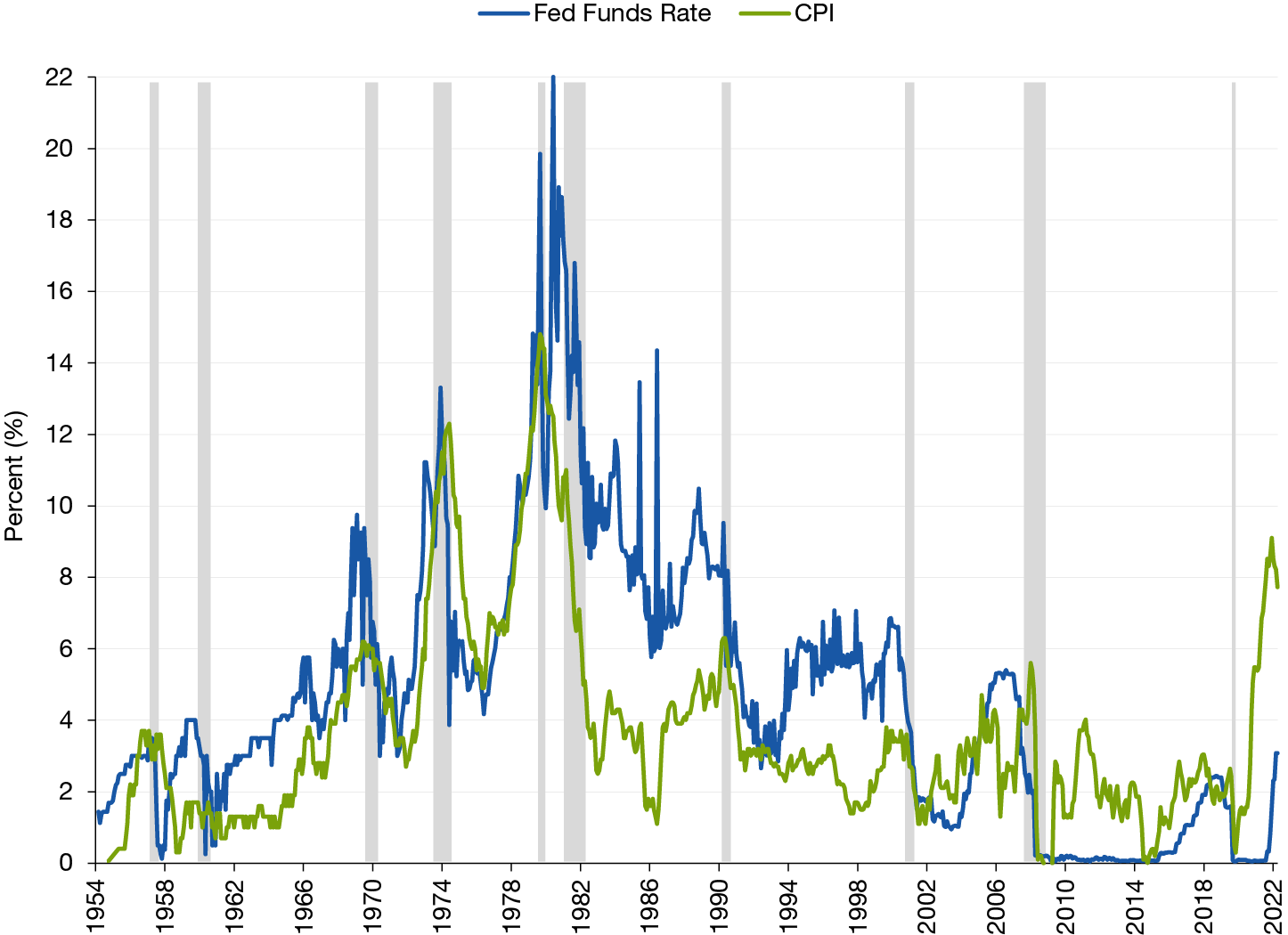
Source: Bloomberg. Data as of 10/31/2022. Inflation is represented by the year-over-year change in the U.S. CPI. The historical data shown in the chart above are for illustrative purposes only and do not represent any specific portfolio managed by Lord Abbett or any particular investment.
As the Fed has aggressively raised rates, including four-consecutive 75-basis point (bp) hikes this year, short-term yields have substantially increased as the market has anticipated Fed moves and priced them in accordingly. In fact, short-term rates have already anticipated much higher rates, as shown in Figure 2.
Figure 2. Short-term Bond Yields are Determined by Fed Expectations
ICE BofA U.S Corporate 1-3 Year Index yield to worst (YTW) and the fed funds target rate, September 20, 2002-October 31, 2022
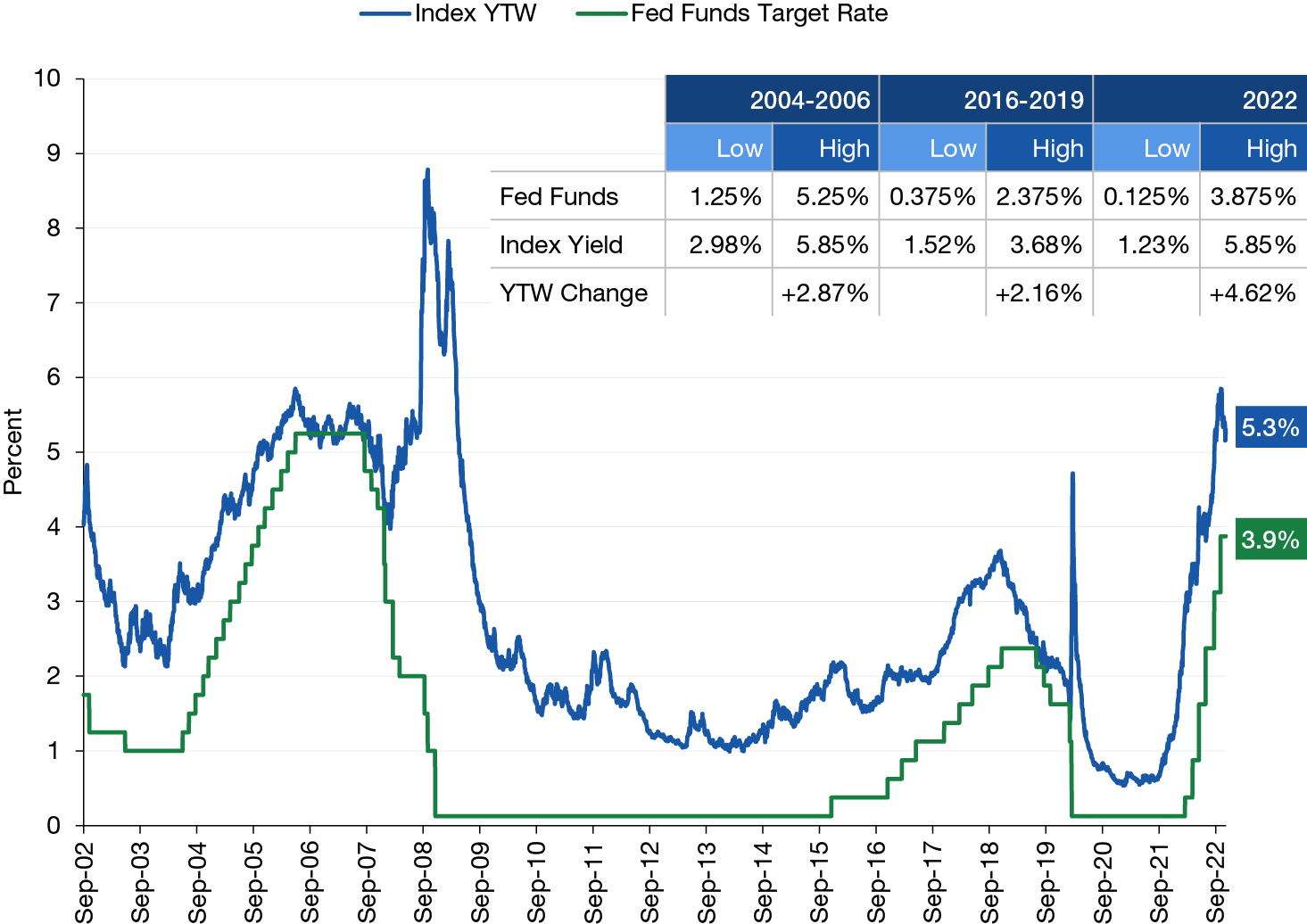
Source: Bloomberg. Data as of 10/31/2022. Index YTW = ICE BofA 1-3 Year Corporate Bond Index yield-to-worst. Yield to worst refers to the lesser of a bond’s (a) yield-to-maturity or (b) the lowest yield-to-call calculated on each scheduled call date. Past performance is not a reliable indicator or guarantee of future results. For illustrative purposes only and does not represent any specific portfolio managed by Lord Abbett or any particular investment. Indexes are unmanaged, do not reflect the deduction of fees and expenses, and are not available for direct investment.
And the underlying rate increases that we have seen from the Fed, thus far, and the impact on short-term bond yields are clearly indicated in the uncommon shape of the U.S. Treasury yield curve, shown in Figure 3.
Figure 3. Big Picture, What’s Happened with Rates
U.S. Treasury yield curve for indicated dates
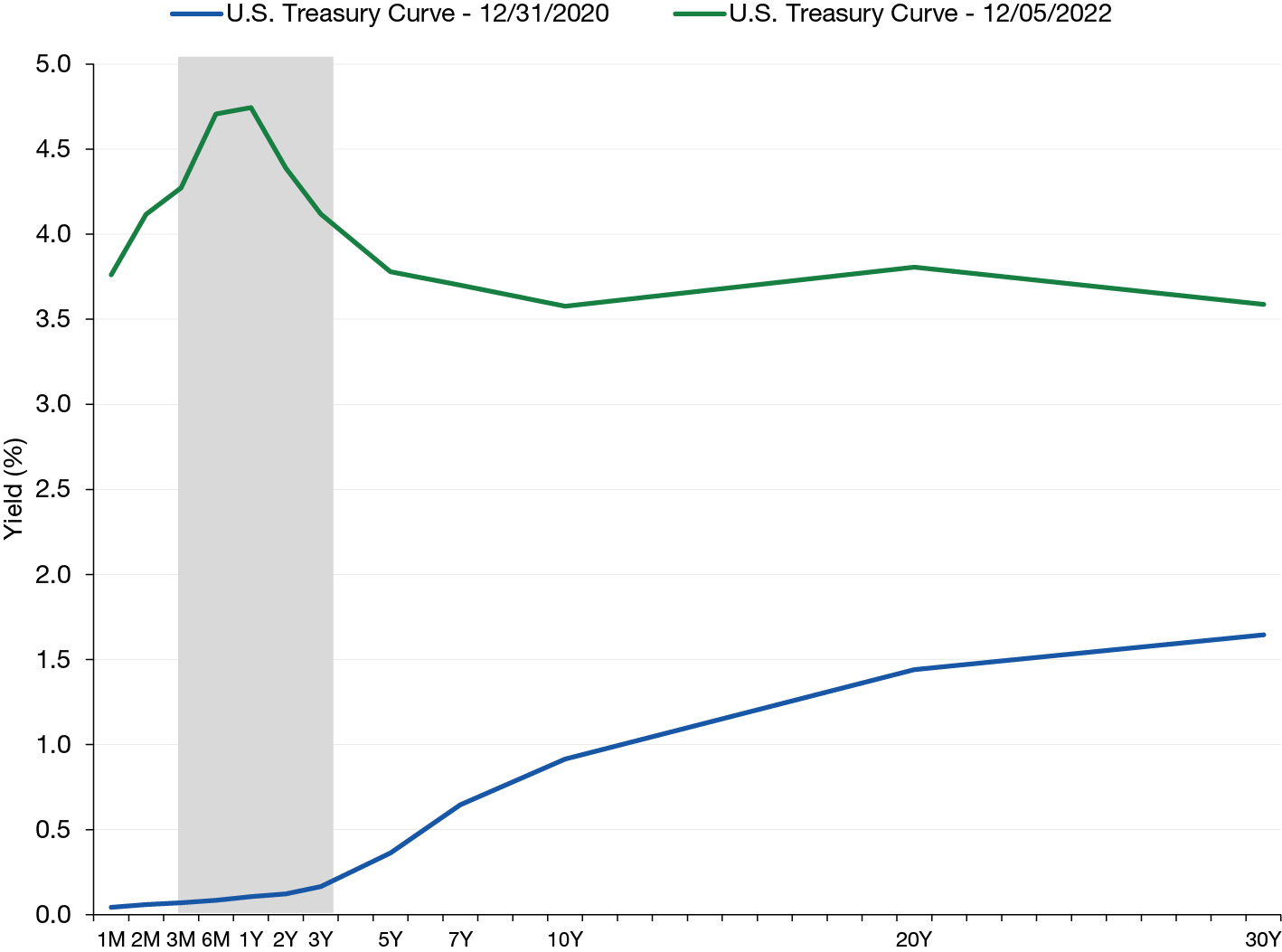
Source: Bloomberg. Data as of 12/05/2022. Past performance is not a reliable indicator or guarantee of future results. The treasury curve is a line that plots the interest rates, at a set point in time, of bonds having equal credit quality, but differing maturity dates. The most frequently reported yield curve compares the three-month, two-year, five-year and 30-year U.S. Treasury debt. For illustrative purposes only and does not represent any specific portfolio managed by Lord Abbett or any particular investment.
The current yield curve inversion, with short-term rates much higher than long-term rates, is historically very extreme and indicates that the market is expecting the economy to slow such that prevailing interest rates do not remain in the 4-5% range. For example, the ten-year Treasury yield is currently below 4%.
Market Expectations of Fed Policy
If we examine the fed funds futures market’s pricing for monetary policy going forward, the expected Fed rate moves during upcoming Federal Open Market Committee (FOMC) meetings, which is the policy-setting arm of the Fed, is shown in the implied policy rate in Figure 4. The change anticipated during the next meeting on December 14 is priced in at approximately 48 bps. The implied policy rate is the black line that corresponds to the left-side axis. The current implied rate is 4.35% or about 48 bps higher than the Fed’s current target rate of 3.9%.
Figure 4. The Market is Pricing in More Hikes and Then Cuts
Fed funds futures pricing and the implied Fed policy rate for indicated FOMC meeting dates.
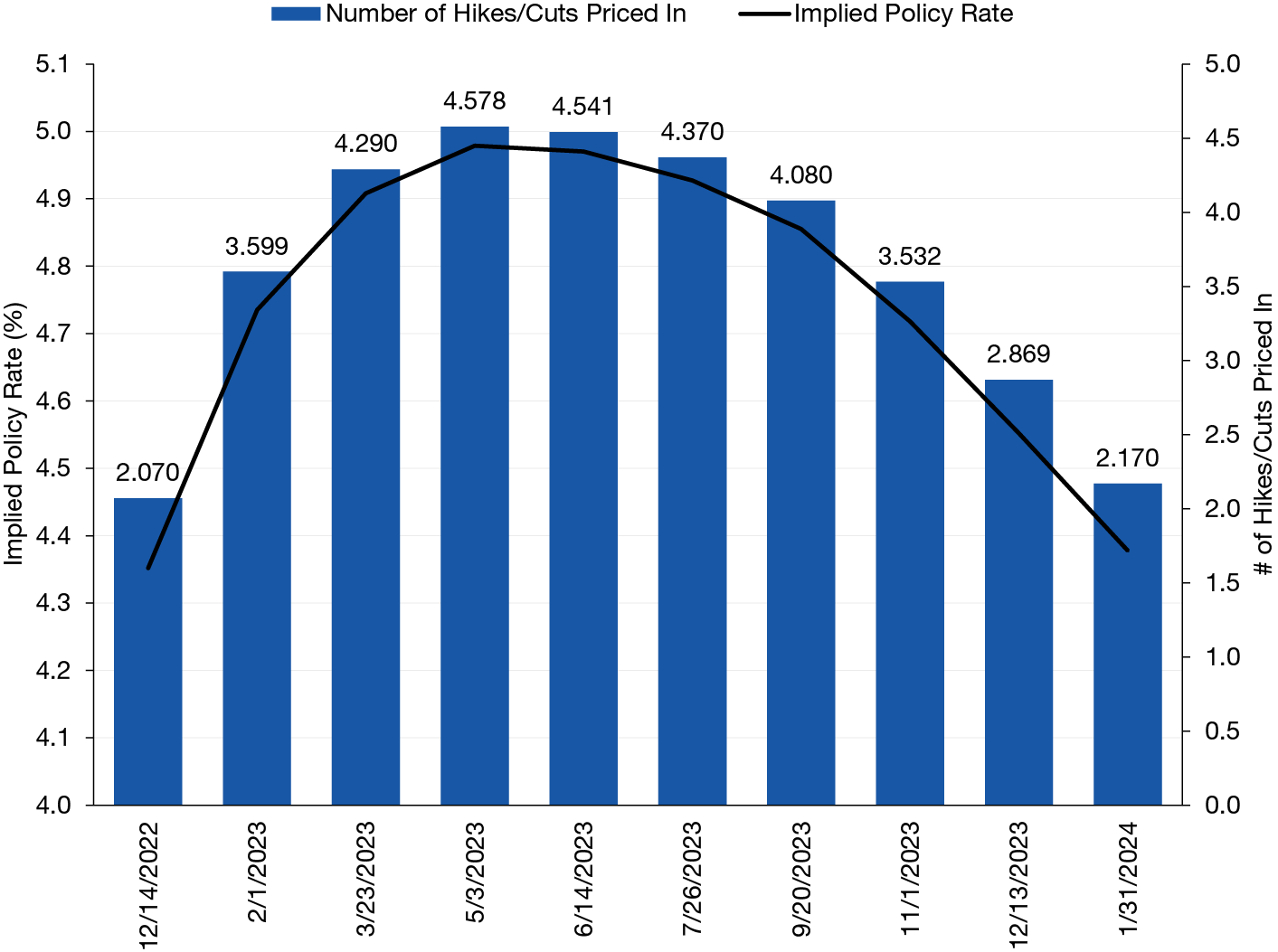
Source: Bloomberg. Data as of 12/06/2022. Fed funds futures are derivatives based on the fed funds rate, the U.S. overnight interbank lending rate on reserves deposited with the Fed. The historical data shown in the chart above are for illustrative purposes only and do not represent any specific portfolio managed by Lord Abbett or any particular investment.
Importantly, the market is anticipating that the Fed’s next move will be about a 50-bp hike, not another 75-bp hike like we have seen this year. Following the December 14 meeting, the market has priced in another 50 bps of hikes between the February and March 2023 meetings. In total, an additional 100 bps in hikes is expected through that period, with an implied rate of approximately 4.9%. As we achieve that terminal rate of around 5%, the market then anticipates that the Fed will begin to cut rates in the fourth quarter of 2023. Typically, rate cuts are not priced in that soon following a hiking cycle. Rates normally plateau for a certain period. But since the Fed and the market realize that monetary policy operates with a lag effect of between six to 12 months, the actual impact of such aggressive increases on the economy are currently unknown, while inflation is still substantially above target. However, the market is pricing fed futures as though inflation will decline, and the economy will slow, prompting the Fed to cut rates later next year.
The Rate & Inflation Disconnect
Joseph Graham: In addition to the atypical direction of fed funds futures pricing in an increase in the probability of rate cuts in late 2023, there are other factors affecting the rate and inflation outlook that have changed since the pandemic. Yet, market participants seem to expect a return to pre-COVID-19 norms, such as a near 2% target rate of inflation. We believe it is important to note significant dynamics that we believe contribute to an extended period of elevated inflation and rates.
Globalization and the efficiency of supply chains have been completely disrupted, first by the pandemic and then by Russia’s invasion of Ukraine and China’s COVID-19 policies. These significant events have caused companies to revamp their supply chains and revert to more local activity with increased redundancy. Although these adaptations may be successful, they increase costs.
ESG (environmental, social, & governance) factors require companies to invest capital for the development of carbon-neutral plans and innovations that reduce or improve the environmental impact of extracting commodities. We believe these additional costs will contribute to upward pricing pressures.
Demographics may also play a significant role in supporting elevated inflation and yields. Prior to the pandemic, an aging demographic was believed to have a deflationary impact, since older members of the population consume less and have excess savings. But aging populations now are, in part, contributing to a reduced labor participation rate as many who left the labor force during the pandemic have not returned.
Labor market dynamics are an important factor that potentially affect inflation in the current economy, and Figure 5 shows just how disconnected the labor market has become. Historically, in a strong cyclical upturn in economic growth, the number of jobs available increases, approaching the number of job seekers. Although labor force participation rates generally have been declining, the number of jobs available per job seeker in the current economy has reached a historic high. This current dislocation in the labor market has not adjusted quickly. As of the end of October 2022, the ratio shown in Figure 5 was 1.75, a substantial level compared to historical measures.
Figure 5. Job Openings Outpace Job Seekers in the U.S.
Ratio of help wanted to the number of unemployed January 31, 1959-October 31, 2022
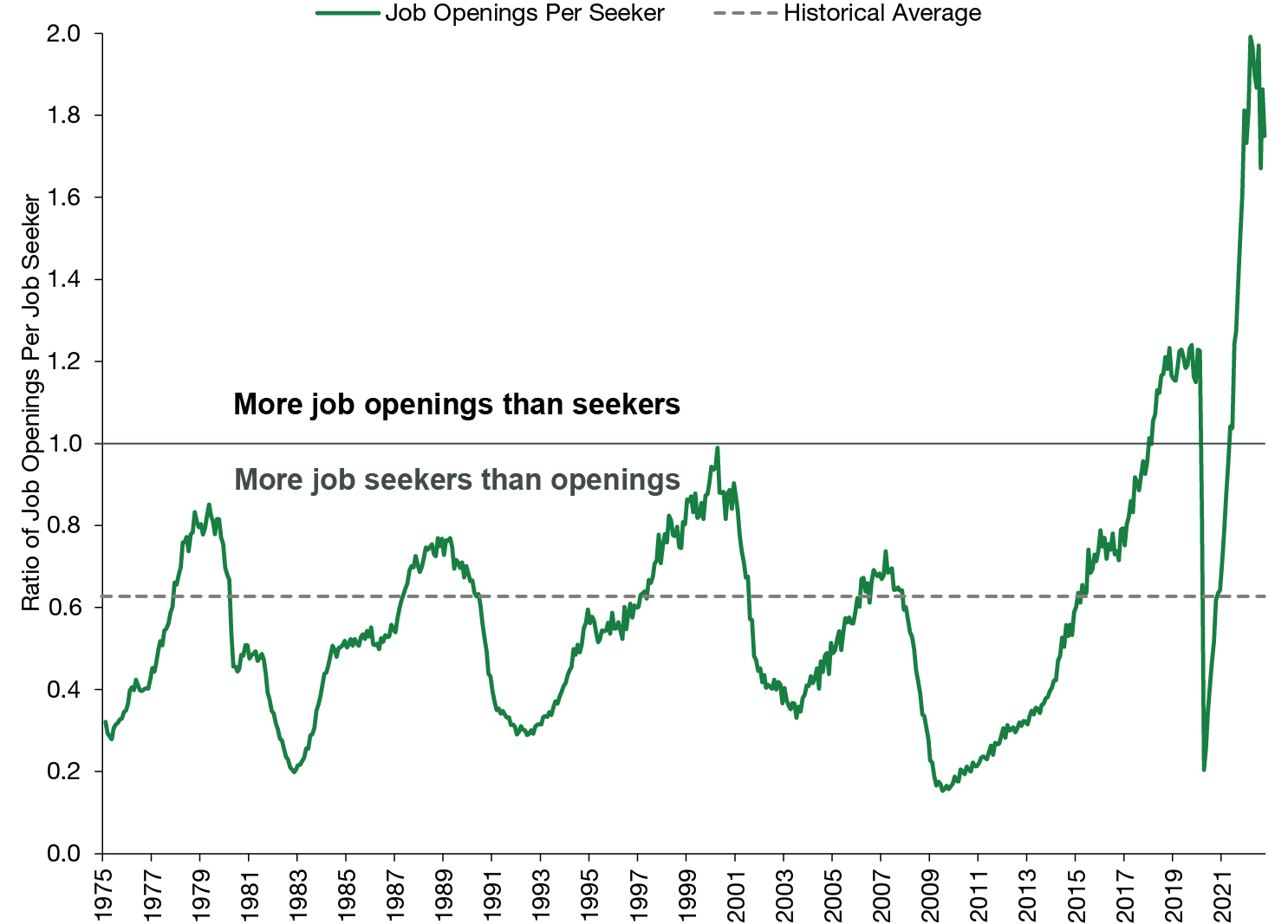
Source: Federal Reserve Bank of St. Louis (Fred). Data as of 09/30/2022. For illustrative purposes only and does not represent any specific portfolio managed by Lord Abbett or any particular investment.
We believe these long-term structural forces will require time to realign within the economy and are supportive of a persistently elevated inflation and rate outlook.
What are the Investment Implications?
Importantly, for fixed-income pricing, when inflation is a major concern, stock and bond returns tend to correlate in a positive way, which creates a challenge for asset allocators seeking to diversify equity volatility with income and stability from bonds. Market concerns have recently shifted toward economic growth and the eventual impact higher rates may have on the economy. Along with this shift in focus on growth, return correlations between stocks and bonds have moved back to negative, promoting potentially better diversification benefits from fixed-income allocations.
And fortunately, there are now attractive yields available on both short-term and long-term maturities (see Figure 6), while stepping out to credit sectors may offer additional yield for incremental risk. The fixed-income investment environment has changed since last year, and now, higher yields provide options that may potentially be a part of a diversified, fixed-income strategy.
Figure 6. Attractive Fixed-Income Opportunities Across Maturities & Sectors
Yield to worst (YTW) on indicated bond indexes as of 11/30/2022
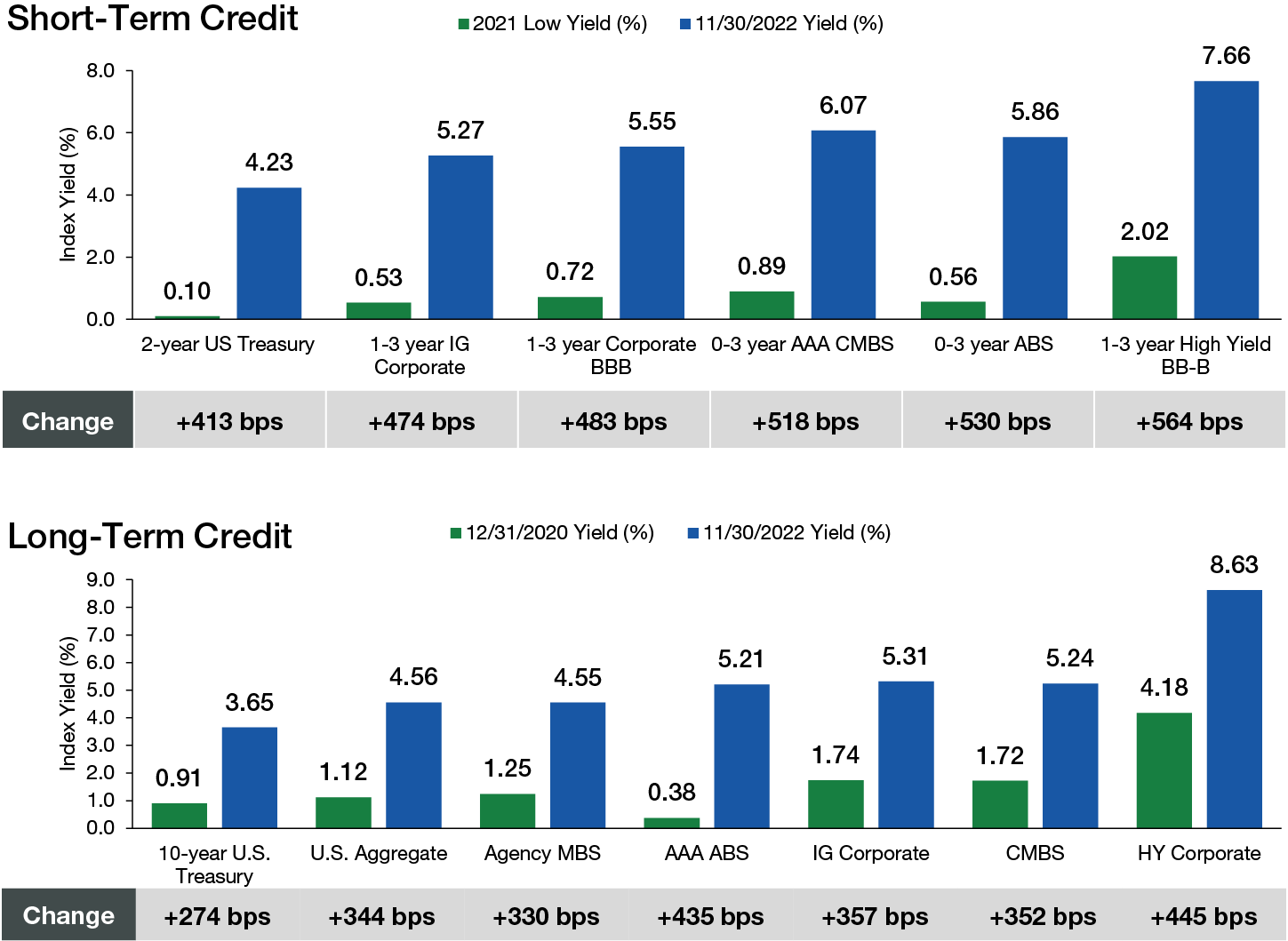
Source: Bloomberg. Data as of 11/30/2022. 1-3 year IG corporate=ICE BofA 1-3 Year Corporate Index. 1-3 year corporate BBB=ICE BofA 1-3 Year BBB Corporate Index. 0-3 year AAA CMBS=ICE BofA 0-3 Year AAA CMBS Index. 0-3 year ABS=ICE BofA 0-3 Year ABS Index. 1-3 year high yield BB-B=ICE BofA 1-3 Year BB/B High Yield Index. U.S. Aggregate=Bloomberg U.S. Aggregate Bond Index. Agency MBS=Bloomberg U.S. MBS Agency Index. AAA ABS=Bloomberg ABS AAA Index. IG Corporate = Bloomberg U.S. Corporate Index. CMBS = Bloomberg CMBS Index. HY Corporate = Bloomberg High Yield Corporate Bond Index. Yield to worst refers to the lesser of a bond’s (a) yield-to-maturity or (b) the lowest yield-to-call calculated on each scheduled call date. CMBS=commercial mortgage-backed security. ABS=asset-backed security. Past performance is not a reliable indicator or guarantee of future results. For illustrative purposes only and does not represent any specific portfolio managed by Lord Abbett or any particular investment. Indexes are unmanaged, do not reflect the deduction of fees and expenses and are not available for direct investment.
And we think institutions may want to take note of the yield pickup in credit because generally, institutional investors have the ability to monetize liquidity premiums that are compelling today relative to history.
Doyle: From a strategic standpoint, as institutions start to re-evaluate their asset allocation and conduct asset/liability studies, we believe capital markets expectations, which are a fundamental input when setting strategic asset allocation parameters, may likely result in higher return expectations for fixed income due to these higher yields.
The good news, in our view, is that bonds can play a larger part in achieving the average 7-7.5% return target institutional investors strive for. Although fixed-income allocations have dropped in institutional portfolios, due to the lower yields that were prevalent in the markets for so long, we believe market valuations have shifted to reflect higher rates creating attractive opportunities in fixed income that are poised to work much harder in investment portfolios going forward.
Graham: To bolster that point, consider those very low yields in the past and bond portfolios’ high-duration sensitivity. Rate volatility in 2022 caused historic negative returns across nearly all fixed-income sectors, and investors may still be concerned about the impact that rate increases will have on bond portfolios in the months ahead.
To address those concerns, we examine the level of rate increases that would be required to achieve breakeven, or the rise in rates that would offset one year of income (see Figure 7).
Figure 7. Higher Starting Yields: A Better Cushion to Absorb a Rise in Rates
One-year breakeven rates across indicated fixed-income indexes, as of 11/30/2022
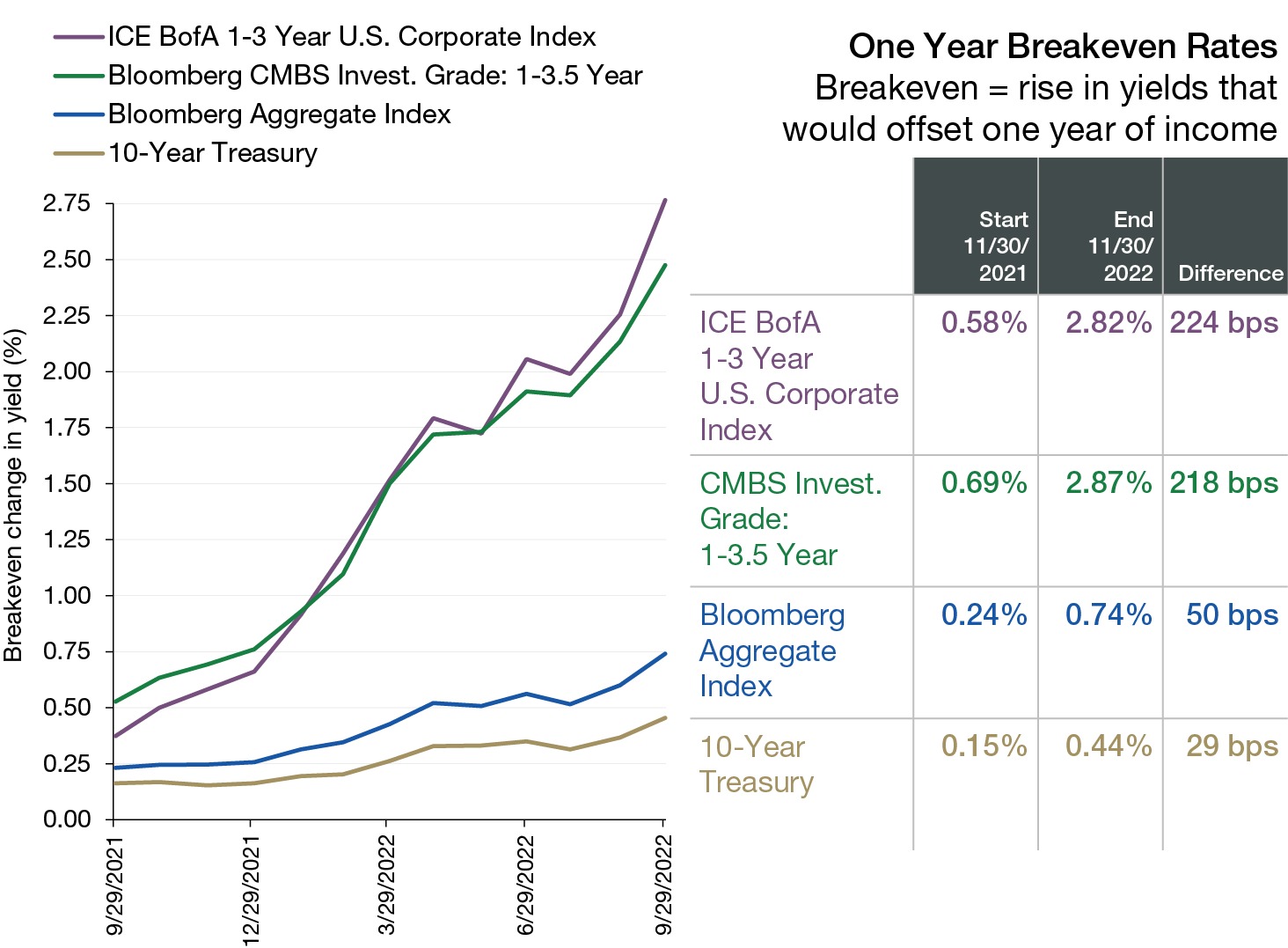
Source: Bloomberg. Data as of 11/30/2022. The Breakeven change in yield is the approximate rise in market yields that would negate one year of income, as measured by the starting index yield. The historical data are for illustrative purposes only, do not represent the performance of any specific portfolio managed by Lord Abbett or any particular investment, and are not intended to predict or depict future results. Indexes are unmanaged, do not reflect the deduction of fees or expenses, and are not available for direct investment.
For example, the one-year breakeven on the ICE BofA 1-3 Year Corporate Index has increased to approximately 282 bps. That means short-term rates would need to climb an additional 282 bps to offset one year of income, a significant improvement relative to breakeven yields just a year ago. And although there is uncertainty in terms of the trajectory of inflation, rates, and Fed policy moves, those 282 bps provide a sizeable cushion going forward.
Overall, we believe the public fixed-income markets currently offer an attractive investment opportunity at these higher yields. In addition, credit sectors may also provide a compelling yield pick-up over Treasuries, given the favorable backdrop of corporate balance sheet strength. We believe inflation will moderate from today’s very high level. But structural changes that will take time to readjust in the economy, such as those impacting supply chains and the labor market, will continue to contribute to elevated inflation and yields for an extended period. Asset allocators may wish to consider fixed income as part of a potential strategic approach to achieving return targets.
As informações aqui contidas estão sendo fornecidas pela GAMA Investimentos (“Distribuidor”), na qualidade de distribuidora do site. O conteúdo deste documento [e informações neste site] contém informações proprietárias sobre LORD ABBETT e o Fundo. Nenhuma parte deste documento nem as informações proprietárias do LORD ABBETT ou DO Fundo aqui podem ser (i) copiadas, fotocopiadas ou duplicadas de qualquer forma por qualquer meio (ii) distribuídas sem o consentimento prévio por escrito do LORD ABBETT. Divulgações importantes estão incluídas ao longo deste documento e que devem ser utilizadas exclusivamente para fins de análise do LORD ABBETT e do Fundo. Este documento não pretende ser totalmente compreendido ou conter todas as informações que o destinatário possa desejar ao analisar o LORD ABBETT e o Fundo e/ou seus respectivos produtos gerenciados ou futuramente gerenciados. Este material não pode ser utilizado como base para qualquer decisão de investimento. O destinatário deve confiar exclusivamente nos documentos constitutivos de qualquer produto e em sua própria análise independente. Nem o LORD ABBETT nem o Fundo estão registrados ou licenciados no Brasil e o Fundo não está disponível para venda pública no Brasil. Embora a Gama e suas afiliadas acreditem que todas as informações aqui contidas sejam precisas, nenhuma delas faz qualquer declaração ou garantia quanto à conclusão ou necessidades dessas informações.
Essas informações podem conter declarações de previsões que envolvem riscos e incertezas; os resultados reais podem diferir materialmente de quaisquer expectativas, projeções ou previsões feitas ou inferidas em tais declarações de previsões. Portanto, os destinatários são advertidos a não depositar confiança indevida nessas declarações de previsões. As projeções e/ou valores futuros de investimentos não realizados dependerão, entre outros fatores, dos resultados operacionais futuros, do valor dos ativos e das condições de mercado no momento da alienação, restrições legais e contratuais à transferência que possam limitar a liquidez, quaisquer custos de transação e prazos e forma de venda, que podem diferir das premissas e circunstâncias em que se baseiam as perspectivas atuais, e muitas das quais são difíceis de prever. O desempenho passado não é indicativo de resultados futuros.

